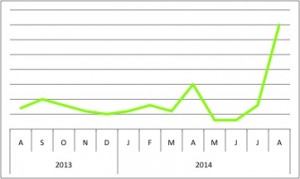In Tanzania, 1 in 1,400 people are targeted for death. That’s the country’s estimated prevalence of albinism,1 a disorder that elsewhere, is far less common and far less dangerous. Since 2006, seventy-one people with albinism have been killed—and that’s just the murders that were reported.2
Local superstition has long regarded albinistic people as cursed beings, ghosts whose body parts are magical talismans. While some fishermen are known to weave albino hair into their nets, witch doctors use albino body parts in potions for success and prosperity. It’s become increasingly unsafe for the albino population, especially girls (who are raped in the misguided belief that this will cure the rapists’ HIV/AIDS) and children, who are often targeted for dismemberment.3 Thinking that it’ll enhance the witchcraft, attackers will even cut off the limbs while the victims are still alive. All together, a full “albino set” (ears, nose, tongue, genitals, limbs) sells for $75,000.4 For a country whose annual per capita income is $442, the illegal (but lucrative) market for albino body parts has forced at least 10,000 East Africans into hiding.5 At such a high price, it could only be the social and political elite driving this trade; indeed, some sources indicate that attacks rise before elections—just in time to purchase some good luck.6

Elsewhere in the world, albinistic people may not be violently pursued, but will still face everyday discriminations. This baby with albinism is just 23 days old. [Image by Felipe Fernandes.]
Cultural myths may ascribe a supernatural origin for albinism, but its cause is decidedly genetic. Characterized by lack of pigment in the skin, hair, and eyes, albinism is a recessive genetic condition that can occur from a variety of mutations; each of these gene variants ultimately affects production of melanin pigment. In sub-Saharan Africa, the most common cause of albinism is a 2.7 kb deletion in the OCA2 gene.7
The OCA2 gene (formerly called the P gene) encodes the P protein, whose exact function remains unknown. P protein is almost exclusively located in melanocytes (the cells that produce melanin), and may be involved in the following functions:8
- Transport of tyrosinase, the enzyme that makes melanin.
- Regulation of pH conditions in the melanosome, the organelles where melanin is synthesized, stored, and transported.
Ultimately, OCA2 mutations disrupt melanin pigment levels, giving rise to a specific subtype of albinism (OCulocutaneous Albinism, type 2) that affects both the eyes and skin; lack of melanin not only increases chance of skin cancer, but also results in abnormal eye development—and thus poor vision.
While large (or similarly severe) deletions in the OCA2 gene can cause the drastic effects of albinism, small changes can account for normal variation in skin and eye color. Indeed, the difference of a single amino acid accounts for light skin in East Asian populations, while other distinct OCA2 gene variants describe fair-skinned European populations.9 Similarly, much of the switch between blue or brown eye color can be explained by a single nucleotide change that affects OCA2 gene activation.10
It’s these small variations in our genome that has determined the course of history, that has defined our concept of race, and for some people with albinism, continues to be a matter of life and death. September is Albinism Awareness Month, and when an entire group of people isn’t being treated, or even considered, as human, change has to happen at the most fundamental level. After all, in the end, how much do slight genetic differences really matter? Biologically speaking, they matter a lot. But culturally, they shouldn’t have to.

Brown-eyed, blue-eyed? Dark-skinned, light-skinned? Albinistic? OCA2 matters—but we don’t have to let it. Support #AlbinismAwarenessMonth. [Image by Felipe Fernandes.]

While there haven’t been many recent publications on OCA2 gene function, this month does happens to be Albinism Awareness Month.
Are you horrified about the persecution of people with albinism? Me too. Check out this full-length feature article and a stunning series of photographs at National Geographic.
Confused about whether “albino” is a derogatory term? Read this. And then spread the word about #AlbinismAwarenessMonth.
REFERENCES:
- Tuli AM, Valenzuela RK, Kamugisha E, Brilliant MH. (2012) Albinism and disease causing pathogens in Tanzania: are alleles that are associated with OCA2 beingmaintained by balancing selection? Med Hypotheses 79(6):875-8. [↩]
- Ingber, Sasha. “Pictures: Inside the Lives of Albinos in Tanzania.” National Geographic: News. 25 January 2013. Retrieved 14 September 2014 from http://news.nationalgeographic.com/news/2013/01/130125-albino-albinism-tanzania-witch-doctors/ [↩]
- Gilgoff, Dan. “As Tanzania’s Albino Killings Continue, Unanswered Questions Raise Fears.” National Geographic: News. 11 October 2013. Retrieved 14 September 2014 from http://news.nationalgeographic.com/news/2013/10/131011-albino-killings-witch-doctors-tanzania-superstition/ [↩]
- Ingber, Sasha. “Pictures: Inside the Lives of Albinos in Tanzania.” National Geographic: News. 25 January 2013. Retrieved 14 September 2014 from http://news.nationalgeographic.com/news/2013/01/130125-albino-albinism-tanzania-witch-doctors/ [↩]
- Ingber, Sasha. “Pictures: Inside the Lives of Albinos in Tanzania.” National Geographic: News. 25 January 2013. Retrieved 14 September 2014 from http://news.nationalgeographic.com/news/2013/01/130125-albino-albinism-tanzania-witch-doctors/ [↩]
- Oakford, Samuel. “Fueled by Superstition, People Are Violently Attacking Albinos in Tanzania.” Vice News. 27 August 2014. Retrieved 14 September 2014 from https://news.vice.com/article/fueled-by-superstition-people-are-violently-attacking-albinos-in-tanzania [↩]
- Rimoldi V, Straniero L, Asselta R, Mauri L, Manfredini E, Penco S, Gesu GP, Del Longo A, Piozzi E, Soldà G, Primignani P. (2014) Functional characterization of two novel splicing mutations in the OCA2 gene associated with oculocutaneous albinism type II. Gene 537(1):79-84. [↩]
- Rimoldi V, Straniero L, Asselta R, Mauri L, Manfredini E, Penco S, Gesu GP, Del Longo A, Piozzi E, Soldà G, Primignani P. (2014) Functional characterization of two novel splicing mutations in the OCA2 gene associated with oculocutaneous albinism type II. Gene 537(1):79-84. [↩]
- Edwards M, Bigham A, Tan J, Li S, Gozdzik A, Ross K, Jin L, Parra EJ. (2010) Association of the OCA2 polymorphism His615Arg with melanin content in east Asian populations: further evidence of convergent evolution of skin pigmentation. PLoS Genet 6(3): e1000867. [↩]
- Sturm RA, Larsson M. (2009) Genetics of human iris colour and patterns. Pigment Cell Melanoma Res 22(5):544-62. [↩]

great article